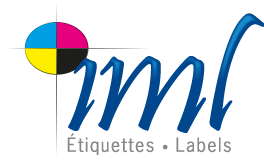ANY QUESTIONS?
ASK THEM NOW!
FAQ
Identifying an Injection Molder with IML capabilities is the first step of the transition, as the process of in-mold labeling usually requires a minimum of automation. You must carefully select the plastic container that will display your new IML branding! Since this type of decoration is growing in popularity, there are now many molders on the market that are able to help bring your project to life. IML Labels can be your partner at different steps of the transition, whether it is for marketing samples, to review artworks, to test die-lines, etc. Our unique digital printing technology offers opportunities even before the official launch in production.
In reality, an IML Label does not “stick” to the container: it becomes a part of it! The plastic label will form a bond with the injected part at molding, when three (3) factors come together: heat, pressure and compatibility of materials. After molding, the label is permanent and can no longer be removed, while showing outstanding durability and resistance.
The In-Mold Blow molding process is very similar to the Injection Molding one, and we can provide labels for both applications.
Even though our labels are in polypropylene, we have had many experiences of different projects requiring adhesion with various resin mixes. In such a case, we can supply different label materials and die-cut based on your specifications to test compatibility.
In any event, we strongly recommend to get our Customer Service team involved as early as possible in the project. Our experts will preflight your artwork and issue recommendations, if any, to help optimize the label printing, die-cutting and molding process. In this specific case, our 220Lpi printing and innovative screening have repeatedly shown excellent spot color reproduction. Please refer to our complete Guideline for more information regarding artwork.
Although it is also common to provide labels with a smooth finish, the “orange peel” effect is probably one of the most appealing characteristics of IML. In order to create this effect, we use a “cavitated” BOPP film. Structured like a sponge, it collapses at molding and changes the surface finish. Please contact our Customer Service team for more information regarding the different substrates available.
Absolutely! The simplest way is usually to use a clear label.
We do not require a minimum order quantity. With our digital printing capabilities, we can print as little as a few labels! If a small project was to become larger, we will ensure outstanding color consistency between digital and offset printing.
We consistently provide labels within a 3-4 weeks lead time. On occasion, we have expedited deliveries in just a couple of days!
Most packages on the market have labels that are a combination of materials, or that require adhesives that alter recyclability. IML labels are made exclusively of polypropylene and is usually molded on a container made of the same plastic. With no lamination and no bonding agent, the final container can then be easily ground and recycled! At IML Labels, we give our production waste a second life by supplying recycled resin for various projects. IML is also a single-process operation that will necessarily simplify your process and logistics chain.
About 80% of our production are labels used in the food industry. We guarantee the use of Raw Materials suitable for non-direct food contact as well as Low-Migration inks. We also conduct yearly Extraction Testing to confirm that there is no migration due to the label in the final package.



